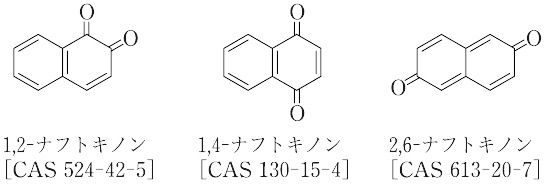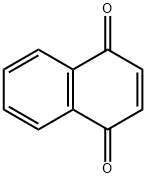-
外観
黄色~黄褐色又は暗黄緑色, 結晶性粉末~粉末
-
性質
ナフトキノンは、有機化合物であり、キノン構造を持つナフタレン誘導体です。1,4-ナフトキノンは黄色からオレンジ色の結晶で、特有の刺激臭があります。無水物は融点約124℃、沸点は>300℃と報告されています。
水への溶解度は低いですが、アルコール、エーテル、アセトンなどの極性有機溶媒には溶けやすくなります。二重結合とカルボニル基が環状に並ぶキノン構造は、容易に還元され、ヒドロキノン構造へ変換されます。また、1,4-ナフトキノンは、空気中で酸化されやすいため、光や空気から遮断された容器で保存することが重要です。
-
溶解性
熱エタノールに溶ける。
-
解説
naphthalenedione.C10H6O2(158.16).ナフタレン核をもつキノンであるが,1,2-,1,4-および2,6-ナフトキノンの3種類の異性体がある. 1,2-および1,4-ナフトキノンは,それぞれ1-アミノ-2-ナフトールあるいは4-アミノ-1-ナフトールを二クロム酸カリウムの希硫酸溶液で酸化すると得られる.ナフトキノンは,ナフタレン環骨格をもつキノン。いずれもキノン特有の色をもっている結晶である。1,4-ナフトキノンの誘導体は動物色素として天然に分布している。単にナフトキノンというと1,4-ナフトキノンをさす。ナフトキノン系染料やビタミンKも1,4-ナフトキノンの骨格をもっている。1,2-ナフトキノンは赤色の結晶で有毒である。ディーゼルエンジンの排気ガスに含まれている。2,6-ナフトキノンは不安定で、溶液中ではすぐに分解する(図)。1,2-ナフトキノンは赤色の結晶.分解点115~120 ℃.λmax 250,340,405 nm(log ε 4.35,3.40,3.40).エタノール,ベンゼン,エーテルに可溶,水に不溶.濃硫酸呈色は緑色.1,4-ナフトキノンは五酸化バナジウム系触媒によるナフタレンの空気酸化によっても得られる.黄色の昇華性結晶.融点125 ℃.特異臭があり,水蒸気蒸留される.アルカリ水溶液に溶けて赤褐色を呈する.ビタミンKはその誘導体である.2,6-ナフトキノンはamphi-ナフトキノンともいわれ,2,6-ジヒドロキシナフタレンを酸化鉛(Ⅳ)で酸化すると得られる.橙色の結晶.分解点130~135 ℃.森北出版「化学辞典(第2版)
1,2-および1,4-ナフトキノンは,それぞれ1-アミノ-2-ナフトールあるいは4-アミノ-1-ナフトールを二クロム酸カリウムの希硫酸溶液で酸化すると得られる.ナフトキノンは,ナフタレン環骨格をもつキノン。いずれもキノン特有の色をもっている結晶である。1,4-ナフトキノンの誘導体は動物色素として天然に分布している。単にナフトキノンというと1,4-ナフトキノンをさす。ナフトキノン系染料やビタミンKも1,4-ナフトキノンの骨格をもっている。1,2-ナフトキノンは赤色の結晶で有毒である。ディーゼルエンジンの排気ガスに含まれている。2,6-ナフトキノンは不安定で、溶液中ではすぐに分解する(図)。1,2-ナフトキノンは赤色の結晶.分解点115~120 ℃.λmax 250,340,405 nm(log ε 4.35,3.40,3.40).エタノール,ベンゼン,エーテルに可溶,水に不溶.濃硫酸呈色は緑色.1,4-ナフトキノンは五酸化バナジウム系触媒によるナフタレンの空気酸化によっても得られる.黄色の昇華性結晶.融点125 ℃.特異臭があり,水蒸気蒸留される.アルカリ水溶液に溶けて赤褐色を呈する.ビタミンKはその誘導体である.2,6-ナフトキノンはamphi-ナフトキノンともいわれ,2,6-ジヒドロキシナフタレンを酸化鉛(Ⅳ)で酸化すると得られる.橙色の結晶.分解点130~135 ℃.森北出版「化学辞典(第2版)
-
用途
ゴム及びポリエステル樹脂の重合調整剤として、染料ならびに医薬品の合成に用いられる。アントラキノンの製造中間体
-
用途
有機合成原料
-
構造
1,4-ナフトキノンは、二環式の芳香族炭化水素であるナフタレンの1位と4位にカルボニル基が結合した構造を持っています。平面的な構造を持っており、分子内で二重結合とカルボニル基が交互に並ぶ共役系が形成されています。
π電子が全体に広がっているため、紫外線や可視光線を吸収するのが特徴です。この特徴は、染料や顔料としての利用に関連しています。
分子式はC10H6O2であり、IUPAC名は「4H-cyclopenta[def]phenanthrene-4,5(1H,3H)-dione」です。1,4-ナフトキノンの構造は容易に還元される性質を持っており、還元されると、ヒドロキノン構造へ変換されます。
また、この構造は生体内で重要な役割を果たす化合物の基本骨格でもあります。例えば、ビタミンK、ウビキノン (コエンザイムQ) などは、1,4-ナフトキノンの基本骨格を持つ化合物です。
-
化学的特性
1,4-Naphthoquinone is a yellow to greenish yellow crystalline solid that has pungent odor like benzoquinone. It is slightly soluble in water, soluble in ether, chloroform, benzene, glacial acetic acid. In alkaline solutions it produces a reddish-brown color.
-
使用
1,4-Naphthoquinone is used as a strong dienophile in Diels-Alder reaction. It is also used as a precursor to anthroquinone and 5-nitro-1,4-naphthalenedione, which finds application in the preparation of aminoanthroquinone and is also used as a dye precursor. It is a basic component of Vitamin K.
-
定義
ChEBI: 1,4-naphthoquinone is the parent structure of the family of 1,4-naphthoquinones, in which the oxo groups of the quinone moiety are at positions 1 and 4 of the naphthalene ring. Derivatives have pharmacological properties. It derives from a hydride of a naphthalene.
-
一般的な説明
Yellow needles or brownish green powder with an odor of benzoquinone.
-
空気と水の反応
Insoluble in water.
-
反応プロフィール
1,4-Naphthoquinone may react with many acids and bases liberating heat and flammable gases (e.g., H2). The heat may be sufficient to start a fire in the unreacted portion of the ketone. May react with reducing agents such as hydrides, alkali metals, and nitrides to produce flammable gas (H2) and heat. Incompatible with isocyanates, aldehydes, cyanides, peroxides, and anhydrides. May react violently with aldehydes, HNO3, HNO3 + H2O2, and HClO4.
-
危険性
Irritant
-
健康ハザード
ACUTE/CHRONIC HAZARDS: When heated to decomposition 1,4-Naphthoquinone emits toxic fumes and smoke.
-
火災危険
Flash point data for 1,4-Naphthoquinone are not available; however, 1,4-Naphthoquinone is probably combustible.
-
使用用途
ナフトキノンは、さまざまな工業的用途を持つ化学物質を合成する原料として使用されています。ディールス・アルダー反応の名で知られるナフトキノンと1,3-ジエンの反応では、アントラキノンを合成可能です。アントラキノンは、さまざまな色素の原料やパルプを製造する際の触媒として用いられます。
また、ナフトキノンのジアゾ誘導体であるジアゾナフトキノンは、半導体の製造過程における水銀露光などに用いられています。ナフトキノンの誘導体には細胞毒性を持つものが多く、抗ウイルス剤や解熱剤などに使用されるものもあります。
1,4-ナフトキノンおよびその誘導体は、抗菌、抗真菌、抗ウイルス、抗炎症、抗がんなどの薬理作用が報告されており、これらの効果を利用した医薬品が開発されています。また、そのほか、高い着色力を持つため、染料や顔料として用いられます。特に、赤色や黄色の染料には、ナフトキノン誘導体が有用です。
-
安全性プロファイル
Poison by ingestion,
intravenous, subcutaneous, and
intraperitoneal routes. Experimental
reproductive effects. Questionable
carcinogen with experimental tumorigenic
data. When heated to decomposition it
emits acrid smoke and irritating fumes.
-
合成
1,4-Naphthoquinone is prepared by reacting naphthalene with molecular oxygen in a gaseous phase in the presence of a catalyst containing vanadium.
Prior to reacting the naphthalene with oxygen, the catalyst is pre-treated with molecular oxygen at 300° to 400° C in the absence of organic compounds and immediately thereafter a gas mixture containing naphthalene and molecular oxygen is passed over the pretreated catalyst at temperatures in the range of 300° to 400° C. The catalyst pre-treatment can be carried out in the presence of water vapor and the subsequent reaction of naphthalene with molecular oxygen can also be carried out in the presence of water vapor.
-
職業ばく露
1,4-Naphthoquinone is used as a polymerization
regulator for rubber and polyester resins; in the
synthesis of dyes and pharmaceuticals; and as a fungicide
and algicide.
-
製造方法
ナフトキノンの製造方法
1,4-ナフトキノンは、通常、ナフタレンから誘導されます。ナフタレンにクロム酸ナトリウムなどの酸化剤を作用させることで、1,4-ナフトキノンが生成されます。
また、他の方法として、アントラキノン誘導体の環縮合や、1,4-ナフトールの酸化などが挙げられます。
-
輸送方法
UN2811 Toxic solids, organic, n.o.s., Hazard
Class: 6.1; Labels: 6.1-Poisonous materials, Technical
Name Required.
-
合成方法
ナフタレンを空気酸化することにより製造される。
-
純化方法
Crystallise the quinone from diethyl ether (charcoal). It distils in steam. It also crystallises from *benzene or aqueous EtOH and sublimes in a vacuum. [Beilstein 7 IV 2422.]
-
不和合性
Ketones are incompatible with oxidizers
(chlorates, nitrates, peroxides, permanganates, perchlorates,
chlorine, bromine, fluorine, etc.); contact may cause fires
or explosions. Keep away from alkaline materials, strong
bases, strong acids, oxoacids, epoxides, nitrated amines,
azo, diazo, azido compounds, carbamates, organic cyanates.
May react with many acids and bases liberating heat and
flammable gases (e.g., hydrogen) generating heat may be
sufficient to start a fire in the unreacted portion of the
ketone. May react with reducing agents such as hydrides,
alkali metals, and nitrides to produce flammable gas
(e.g., hydrogen) and heat. Incompatible with isocyanates,
aldehydes, cyanides, peroxides, and anhydrides. May react
violently with aldehydes.
-
廃棄物の処理
Consult with environmental
regulatory agencies for guidance on acceptable disposal
practices. Generators of waste containing this contaminant
(≥100 kg/mo) must conform with EPA regulations governing
storage, transportation, treatment, and waste disposal.




 1,2-および1,4-ナフトキノンは,それぞれ1-アミノ-2-ナフトールあるいは4-アミノ-1-ナフトールを二クロム酸カリウムの希硫酸溶液で酸化すると得られる.ナフトキノンは,ナフタレン環骨格をもつキノン。いずれもキノン特有の色をもっている結晶である。1,4-ナフトキノンの誘導体は動物色素として天然に分布している。単にナフトキノンというと1,4-ナフトキノンをさす。ナフトキノン系染料やビタミンKも1,4-ナフトキノンの骨格をもっている。1,2-ナフトキノンは赤色の結晶で有毒である。ディーゼルエンジンの排気ガスに含まれている。2,6-ナフトキノンは不安定で、溶液中ではすぐに分解する(図)。1,2-ナフトキノンは赤色の結晶.分解点115~120 ℃.λmax 250,340,405 nm(log ε 4.35,3.40,3.40).エタノール,ベンゼン,エーテルに可溶,水に不溶.濃硫酸呈色は緑色.1,4-ナフトキノンは五酸化バナジウム系触媒によるナフタレンの空気酸化によっても得られる.黄色の昇華性結晶.融点125 ℃.特異臭があり,水蒸気蒸留される.アルカリ水溶液に溶けて赤褐色を呈する.ビタミンKはその誘導体である.2,6-ナフトキノンはamphi-ナフトキノンともいわれ,2,6-ジヒドロキシナフタレンを酸化鉛(Ⅳ)で酸化すると得られる.橙色の結晶.分解点130~135 ℃.森北出版「化学辞典(第2版)
1,2-および1,4-ナフトキノンは,それぞれ1-アミノ-2-ナフトールあるいは4-アミノ-1-ナフトールを二クロム酸カリウムの希硫酸溶液で酸化すると得られる.ナフトキノンは,ナフタレン環骨格をもつキノン。いずれもキノン特有の色をもっている結晶である。1,4-ナフトキノンの誘導体は動物色素として天然に分布している。単にナフトキノンというと1,4-ナフトキノンをさす。ナフトキノン系染料やビタミンKも1,4-ナフトキノンの骨格をもっている。1,2-ナフトキノンは赤色の結晶で有毒である。ディーゼルエンジンの排気ガスに含まれている。2,6-ナフトキノンは不安定で、溶液中ではすぐに分解する(図)。1,2-ナフトキノンは赤色の結晶.分解点115~120 ℃.λmax 250,340,405 nm(log ε 4.35,3.40,3.40).エタノール,ベンゼン,エーテルに可溶,水に不溶.濃硫酸呈色は緑色.1,4-ナフトキノンは五酸化バナジウム系触媒によるナフタレンの空気酸化によっても得られる.黄色の昇華性結晶.融点125 ℃.特異臭があり,水蒸気蒸留される.アルカリ水溶液に溶けて赤褐色を呈する.ビタミンKはその誘導体である.2,6-ナフトキノンはamphi-ナフトキノンともいわれ,2,6-ジヒドロキシナフタレンを酸化鉛(Ⅳ)で酸化すると得られる.橙色の結晶.分解点130~135 ℃.森北出版「化学辞典(第2版)